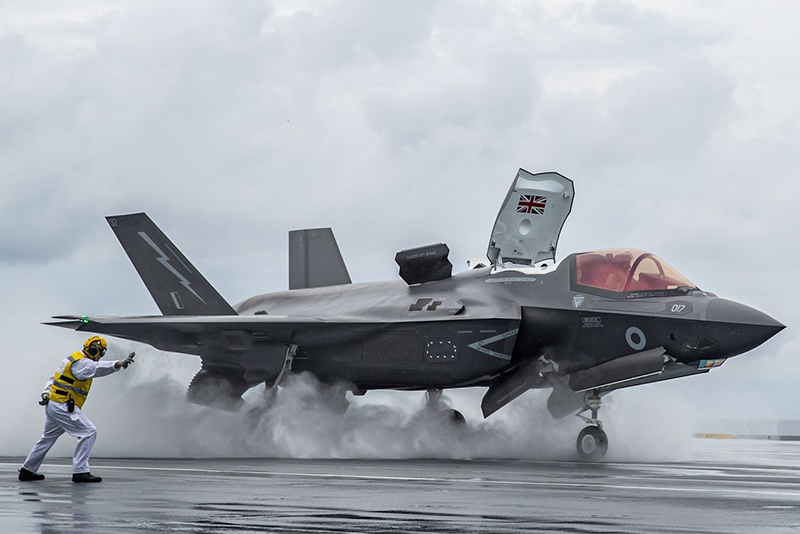By next year, Singapore will be one of the very few countries in the world to operate the F-35B Lightning II fighter jets only from land-based airfields. These aircraft are normally used from aircraft carriers or amphibious assault ships, but Singapore is choosing a different path.
Singapore’s F-35B Game-Changing Move
This action goes beyond simply equipping the Republic of Singapore Air Force (RSAF) with a new fighter plane. In terms of Singapore’s defense strategy, it marks a significant shift. An aircraft that can take off and land vertically is the F-35B. That means it can take off from short runways and land vertically, like a helicopter.
Singapore’s journey with the F-35B started in 2020 when it ordered four jets. In 2023, the country ordered eight more, bringing the total planned fleet to twelve. These jets will replace ageing F-16C/D Fighting Falcons and work alongside the powerful F-15SG Eagles, giving Singapore a mix of long-range strike power and short-runway flexibility.
⚙️ Grounded glory—F-35B fighter jet repaired in India by elite UK-US team after mysterious snag
The F-35B is one of the most advanced fighter aircraft in the world. It combines stealth technology, advanced sensors, and the ability to operate from places other than large airbases. For Singapore, a small island nation with limited space, this is a key advantage.
Geography and the Need for F-35B Flexibility
Singapore’s geography is one of the main reasons for this decision. The entire country covers only 280 square miles, making it smaller than many big cities around the world. Space for military facilities is limited, and civilian needs take priority in land use.
The closure of Paya Lebar Air Base after 2030 will further reduce available runway space. Traditional fighter jets need long, well-maintained runways to operate, which is a challenge for a nation with limited land. The F-35B solves this problem.
The F-35B can take off and land vertically from runways as small as 550 feet thanks to its STOVL capability. This means it can operate from highway strips, small airfields, or reinforced sections of roads. It can even land in areas designed for quick dispersal during emergencies.
This flexibility increases survivability. If Singapore’s main airbases, like Changi or Tengah, are damaged in an attack, F-35Bs can continue operating from alternative locations. This makes it harder for an enemy to knock out Singapore’s air force in one strike.
In modern warfare, long-range missiles can target runways and airbases early in a conflict. By dispersing its fighter jets, Singapore can avoid losing its airpower at the start of a battle.
🇨🇭 Swiss outrage erupts as Trump slaps record 39% tariffs, shaking F-35 jet deal
Technology That Changes the Balance
The F-35B is not just about short take-offs and vertical landings. It is also a stealth fighter, designed to be difficult to detect by enemy radar. Its shape, special coatings, and ability to carry weapons inside its body make it much harder to track.
Stealth is important in contested airspace. If a pilot can see the enemy first and remain undetected, they can strike before being targeted. The F-35B is equipped with cutting-edge systems like the Active Electronically Scanned Array (AESA) radar, the Distributed Aperture System (DAS), and the Electro-Optical Targeting System (EOTS). These sensors give pilots a complete view of the battlefield, detecting threats in the air, on land, and at sea.
All this data is combined into one easy-to-understand display for the pilot. This process, called sensor fusion, helps make quick, accurate decisions in combat.
The F-35B is also a powerful communication hub. It can share what it sees with other aircraft, ground forces, and naval ships in real time. This means that even if only one F-35B spots a threat, other units can act on that information immediately.
Singapore’s F-15SGs are built for long-range missions and heavy payloads, while the upgraded F-16s still provide multi-role flexibility. The F-35B fits between these roles, offering stealth, advanced sensors, and the ability to operate from more places.
Regional advantage and shift to distributed airpower
Singapore has a distinct position in Southeast Asia because of this expertise. No other ASEAN country currently operates a fifth-generation fighter jet. This puts Singapore ahead in terms of technology, survivability, and combat capability.
Singapore’s location near the Strait of Malacca and the South China Sea also gives it a strategic role in protecting major shipping lanes. The F-35B can help defend these areas and take part in multinational operations with allies who also operate the F-35.
The jets can operate from temporary bases in friendly countries during exercises or emergencies. They can also be deployed to remote islands or hidden locations to extend operational range and avoid predictable patterns.
With its open-architecture systems, the F-35B can be upgraded over time to keep up with new threats and technologies. This means Singapore’s investment will stay relevant for many years.
The decision to use the F-35B from land only is a clear shift in military planning. Instead of relying on a few large, well-protected airbases, Singapore is moving towards a distributed airpower strategy. This approach makes it much harder for an enemy to destroy all of Singapore’s air combat capability in one strike.
The RSAF’s new approach also matches the modern concept of Agile Combat Employment (ACE), which focuses on mobility, rapid deployment, and operating from multiple locations.

